Thomas Gainsborough
- Birth Date:
- 14.05.1727
- Death date:
- 02.08.1788
- Length of life:
- 61
- Days since birth:
- 108792
- Years since birth:
- 297
- Days since death:
- 86430
- Years since death:
- 236
- Extra names:
- Thomas Gainsborough, Томас Гейнсборо, Tomass Geinsboro
- Categories:
- Artist, Painter
- Nationality:
- english
- Cemetery:
- Set cemetery
Thomas Gainsborough FRSA (christened 14 May 1727 – 2 August 1788) was an English portrait and landscape painter. He was the youngest son of John Gainsborough, a weaver in Suffolk. He left home in 1740 to study art in London with Hubert Gravelot, Francis Hayman, and William Hogarth. In 1746, he married Margaret Burr, and they became parents of two daughters. He moved to Bath in 1759 where fashionable society patronised him, and he began exhibiting in London. In 1769, he became a founding member of the Royal Academy, but his relationship with the organization was thorny and he sometimes withdrew his work from exhibition. Gainsborough moved to London in 1774, and painted portraits of the king and queen, but the king was obliged to name as royal painter Gainsborough's rival Joshua Reynolds. In his last years, Gainsborough painted relatively simple landscapes and is credited (with Richard Wilson) as the originator of the 18th century British landscape school. Gainsborough died of cancer in 1788 and is interred at St. Anne's Church, Kew, Surrey. He painted quickly and his later pictures are characterised by a light palette and easy strokes. He preferred landscapes to portraits. Cecil Kellaway portrayed Gainsborough in the 1945 film Kitty.
Life and work
Suffolk
Thomas Gainsborough was born in Sudbury, Suffolk, the youngest son of John Gainsborough, a weaver and maker of woollen goods, and his wife, the sister of the Reverend Humphry Burroughs. When he was 13 he impressed his father with his drawing skills and he was allowed to go to London to study art in 1740. In London he trained under engraver Hubert Gravelot but became associated with William Hogarth and his school. He assisted Francis Hayman in the decoration of the supper boxes at Vauxhall Gardens, and contributed to the decoration of what is now the Thomas Coram Foundation for Children.
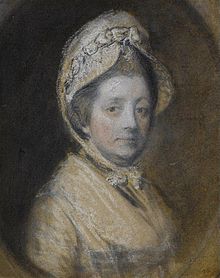
![]()
Margaret Burr (1728–1797), the artist's wife, c. early 1770s
In 1746, Gainsborough married Margaret Burr, an illegitimate daughter of the Duke of Beaufort, who settled a £200 annuity on them. The artist's work, then mainly composed of landscape paintings, was not selling well. He returned to Sudbury in 1748–1749 and concentrated on painting portraits.
In 1752, he and his family, now including two daughters, moved to Ipswich. Commissions for personal portraits increased, but his clientele included mainly local merchants and squires. He had to borrow against his wife's annuity.
Bath

![]()
The Blue Boy (1770). The Huntington, California.
In 1759, Gainsborough and his family moved to Bath, living at number 17 The Circus. There, he studied portraits by van Dyck and was eventually able to attract a fashionable clientele. In 1761, he began to send work to the Society of Arts exhibition in London (now the Royal Society of Arts, of which he was one of the earliest members); and from 1769 he submitted works to the Royal Academy's annual exhibitions. He selected portraits of well-known or notorious clients in order to attract attention. The exhibitions helped him acquire a national reputation, and he was invited to become a founding member of the Royal Academy in 1769. His relationship with the academy was not an easy one and he stopped exhibiting his paintings in 1773.
London
In 1774, Gainsborough and his family moved to London to live in Schomberg House, Pall Mall. A commemorative blue plaque was put on the house in 1951. In 1777, he again began to exhibit his paintings at the Royal Academy, including portraits of contemporary celebrities, such as the Duke and Duchess of Cumberland. Exhibitions of his work continued for the next six years.

![]()
Mr and Mrs William Hallett (1785).
In 1780, he painted the portraits of King George III and his queen and afterwards received many royal commissions. This gave him some influence with the Academy and allowed him to dictate the manner in which he wished his work to be exhibited. However, in 1783, he removed his paintings from the forthcoming exhibition and transferred them to Schomberg House.
In 1784, royal painter Allan Ramsay died and the King was obliged to give the job to Gainsborough's rival and Academy president, Joshua Reynolds. Gainsborough remained the Royal Family's favourite painter, however. At his own express wish, he was buried at St. Anne's Church, Kew, where the Family regularly worshipped.
In his later years, Gainsborough often painted relatively simple, ordinary landscapes. With Richard Wilson, he was one of the originators of the eighteenth-century British landscape school; though simultaneously, in conjunction with Sir Joshua Reynolds, he was the dominant British portraitist of the second half of the 18th century.
He died of cancer on 2 August 1788 at the age of 61 and is interred at St. Anne's Church, Kew, Surrey (located on Kew Green). He is buried next to Francis Bauer, the famous botanical illustrator. As of 2011, an appeal is underway to pay the costs of restoration of his tomb.
Technique

![]()
Mrs Thomas Hibbert, c. 1780s. Neue Pinakothek.
Gainsborough was noted for the speed with which he applied paint, and he worked more from observations of nature (and of human nature) than from application of formal academic rules. The poetic sensibility of his paintings caused Constable to say, "On looking at them, we find tears in our eyes and know not what brings them." Gainsbrough said, "I'm sick of portraits, and wish very much to take my viol-da-gam and walk off to some sweet village, where I can paint landskips (sic) and enjoy the fag end of life in quietness and ease." His liking for landscapes is shown in the way he merged figures of the portraits with the scenes behind them. His later work was characterised by a light palette and easy, economical strokes.
His most famous works, Portrait of Mrs. Graham; Mary and Margaret: The Painter's Daughters; William Hallett and His Wife Elizabeth, nee Stephen, known as The Morning Walk; and Cottage Girl with Dog and Pitcher, display the unique individuality of his subjects.
Gainsborough's only known assistant was his nephew, Gainsborough Dupont. In the last year of his life he collaborated with John Hoppner in painting a full length portrait of Charlotte, Countess Talbot.
In 2011, Gainsborough's portrait of Miss Read (Mrs William Villebois) was sold by Viscount Cowdray for a record price of £6.5M.
In fiction and music
- Kitty (1945) is a notable fictional film about Gainsborough, portrayed by Cecil Kellaway.
- In the song 20th Century Man from the Kinks' 1971 album Muswell Hillbillies, Ray Davies lists Gainsborough as one of the painters he prefers to "your smart modern painters."
Gallery of selected works

Colonel John Bullock (c. 1780)

Landscape in Suffolk (1748), Kunsthistorisches Museum

Mr. and Mrs. Robert Andrews, (c. 1748–1750)

Self-Portrait (1754)
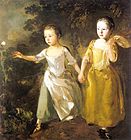
The Painter`s Daughters Chasing a Butterfly, (1756)

Two Daughters with a Cat (c. 1759)
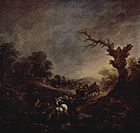
Sunset (1760)

The Artist`s Daughters, Molly and Peggy (1760)

Portrait of the Composer Carl Friedrich Abel with his Viola da Gamba (c. 1765)

John Campbell, 4th Duke of Argyll (1767)
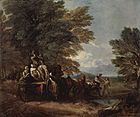
The Harvest Wagon (c. 1767)

Portrait of John Needham, 10th Viscount Kilmorey, (c. 1768), Tate

River Landscape (1768–1770)

Lady in Blue (c. 1770), Hermitage Museum, Saint Petersburg

The Linley Sisters, (1772), Dulwich Picture Gallery
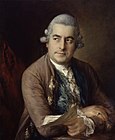
Johann Christian Bach, (1776), Civico Museo Bibliografico Musicale

Gainsborough`s Daughter Mary (1777)
The Honorable Richard Savage Nassau de Zuylestein, M.P., (c. 1778–80), oil on canvas, The Detroit Institute of Arts

Her Grace Georgiana Cavendish, Duchess of Devonshire (1783), National Gallery of Art

The Harvest Wagon (c. 1784)

Mrs. Sarah Siddons (1785), National Gallery

Mrs. Richard Brinsley Sheridan (1785–86), National Gallery of Art

Cottage Girl with Dog and pitcher (1785)

Self-Portrait (1787)

Her Grace Georgiana Cavendish, Duchess of Devonshire, (1787)
Source: wikipedia.org
No places

No relations set
No events set


